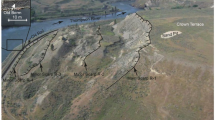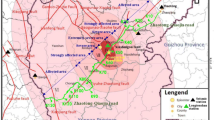Abstract
Among the triggering factors of postearthquake bedrock landslides, rainfall plays an important role. However, with slope variation, the mechanism of its effects on the failure of rock landslides is not clear. Here, from the viewpoint of fracture mechanics, and based on post-earthquake conditions, the mechanisms of crack propagation, water infiltration and development of the sliding surface were investigated. Then, according to the upper boundary theorem, the effects of water infiltrated into fractures on the stability of rock slopes were analyzed quantitatively. Finally, an example is presented to verify the theory. The results show that the propagation and coalescence of cracks and the lubrication of incipient sliding surfaces are the main causes of the failure of post-earthquake rock landslides in response to rainfall.
Similar content being viewed by others
References
Chen HF (1995) Limit analysis and soil plastic. Beijing: China Communications Press. pp. 62–67 (In Chinese).
Chinese Aeronautical Establishment (1981) Handbook of stress intensity factors. Beijing: Science Press. pp 70–91 (In Chinese).
Donald LB (1997) Slope stability analysis by the upper bound approach: fundamentals and methods. Canadian Geotechnical Journal, 34(6): 853–862.
Drucker DC, Prager W (1952) Soil mechanics and plastic analysis or limit design. Quarterly of Applied Mathematics, 10: 157–164.
Guan ZC (2009) Investigation of the 5.12 Wenchuan earthquake damages to the Zipingpu water control project and an assessment of its safety state. Science in China Series E: Technological Sciences, 52(4): 820–834.
Institute of Mountain Hazards and Environment, CAS (2008) The survey report in reconstruction project of high cut slope in Yingxiu-Wenchuan section of National highway 213(317). pp 14–21 (In Chinese).
Iverson RM (2000) Landslide triggering by rain infiltration. Water Resources Research, 36(7): 1897–1910.
Li SY, Yi XC (2006) Rock fracture mechanics. Beijing: Institute of Geophysics China Earthquake Administration. pp 24–32. (In Chinese)
Li XP, He SM (2009) Seismically induced slope instabilities and the corresponding treatments: the case of a road in the Wenchuan earthquake hit region. Journal of Mountain Science, 6(1): 96–100.
Liu LL, Yin KL (2008) Analysis of rainfall infiltration mechanism of rainstorm landslide. Rock and Soil mechanics, 29(4): 1061–1066 (In Chinese).
Mark TJ (1997) Hydrological landslide triggering in ash-covered slopes of Manizales (Columbia). Geomorphology, 20(1—2): 165–175.
Polemio M, Sdao F (1999) The role of rainfall in the landslide hazard: the case of the Avigliano urban area. Engineering Geology, 53(3–4): 297–309.
Wilkinson PL, Anderson MG, Lloyd DM (2002) An Integrated hydrological model for rain-induced landslide prediction. Earth Surface Processes and Landforms, 27(12): 1285–1297.
Xiao XP, Li TB (2005) Analysis of shear strength affected by water content of char weak rock in one certain landslide. Research of Soil and Water Conservation, 12(1): 75–78 (In Chinese).
Xiong B (1996) The motion mechanism of viscous debris. Beijing: Tsinghua University. pp. 47–49 (In Chinese).
Xu JC, Shang YQ, Chen KF, et al. (2005) Analysis of shallow landslide stability under intensive rainfall. Chinese Journal of Rock Mechanics and Engineering, 24(18): 3246–3251 (In Chinese).
Zhang GC, Tang HM, HU B (2007) Study of influence of unsaturated seepage on stability of landslide. Rock and Soil Mechanics, 28(5): 965–970 (In Chinese).
Zhu ZD, Xin FD, Wang SJ, et al. (2004) Analysis on strength softening of argillite under groundwater by damage mechanics. Chinese Journal of Rock Mechanics and Engineering, 23(supp.2): 4739–4743. (In Chinese)
Author information
Authors and Affiliations
Corresponding author
Rights and permissions
About this article
Cite this article
Wu, Y., He, S., Luo, Y. et al. Failure mechanisms of post-earthquake bedrock landslides in response to rainfall infiltration. J. Mt. Sci. 8, 96–102 (2011). https://doi.org/10.1007/s11629-011-2074-y
Received:
Published:
Issue Date:
DOI: https://doi.org/10.1007/s11629-011-2074-y




